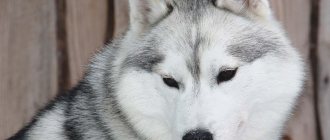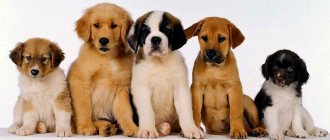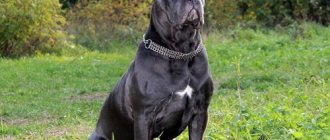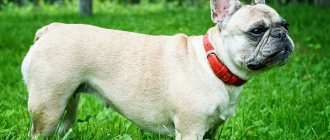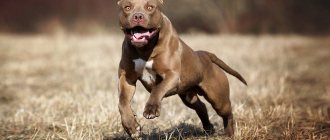Finally, a four-legged barking friend has appeared in the house! You have long dreamed of this, and it doesn’t matter whether you adopted the dog from a breeder with a pedigree or from a shelter. But at the same time, questions arise that require resolution. You need to go to the store and buy everything you need to walk your pet. For example, a leash, a collar, and for some even a muzzle.
In order not to make a mistake in sizes and not waste money, you don’t have to rely on sellers offering a variety of pet products. It’s better to figure out for yourself how to choose the size of a collar for your dog.
Breeds differ from each other, and, of course, the size of the dogs. This means that the collars for them are also different. And what is good for a lapdog or a dachshund will not suit a Doberman or Alabai.
How to choose the size of clothes for a dog
When purchasing a vest, you need the following measurements:
- Chest width. The measurement is taken around the circumference at the widest point - under the pet's chest, just under the armpit. Order the product taking into account the material of the clothing. If it is knitwear, use the resulting measurement; if the fabric does not stretch, add 2-4 cm.
- Neck width. Measure around the circumference where the collar is usually located. When ordering clothes, it is better to add 2-4 cm so that the dog does not suffocate. This option is suitable if clothes are made to order. If you take a ready-made vest, make sure that the neck is not narrower than the pet’s neck, otherwise the lock on the clothing will not have to be fastened completely. The main parameter is the width of the chest.
- Waist length. Measured at the thinnest point of the abdomen. This parameter is important for animals with a wide chest but a thin waist. If you don’t take it into account, the vest in the belly area will be too wide and will look like it came from someone else’s shoulder. If you don’t find the clothes you need, buy a jacket with a drawstring so you can tighten the item.
When buying a vest, the back length is not as important as when choosing a jumpsuit. Manufacturers focus on standard animals, so the clothes will fit if you only specify the width of the chest. Of course, unless you have a dachshund or another breed with atypical parameters.
To choose the right size for your dog, additionally measure:
- Body length. Measurements are taken along the back - from the base of the neck, where the collar is usually located, to the beginning of the tail. It is very important to clearly measure the length of the back; allowances cannot be made. It is better to round down.
- Paw length. The front ones are measured from the chest to the pastern (the topmost nail). Rear - from the belly to the hock joint.
When purchasing clothes, consider your pet's gender. The overalls for males have a special opening in the lower abdomen, while for girls this part is completely closed. There are also universal models, as the manufacturer indicates on the website. In this case, the clothes suit everyone.
Clothing size charts
Before determining the size of overalls for a dog, you must remember that each manufacturer indicates different data. To avoid confusion, measure your pet, open the page of the online store with dog clothes, and find the necessary parameters in the table.
If the table of clothing sizes is not indicated, there is no need to think about how to find out the size of overalls for a dog. It is better to refuse to purchase from this online store. Buy clothes on another site where all the details are provided. If you specifically need a jumpsuit, the parameters of which you don’t know, contact the seller and check the clothing sizes.
Requirements for a dog accessory
In order for the accessory to serve for a long time and not cause inconvenience to the animal, it is necessary to take into account the breed, age, character traits, and also adhere to the basic recommendations when choosing it:
- size matching;
- Collars that are replete with various decorative decorations on the outside are not suitable for everyday wear, as the animal can be injured by them;
- high-quality tailoring. There should be no threads sticking out on the accessory, no sharp elements of the collar protruding, and the strap should have several holes to make it more convenient;
Every dog will need this item.
- suitable width. Here it is necessary to take into account the breed and size of the dog, since narrow collars for dogs of large breeds (for example, a German shepherd or Labrador) will simply dig into the neck;
- reliable fastening of the ring;
- use of quality materials.
Soft homemade products are used for puppies
How to determine your dog's shoe size
If you want to buy shoes for your dog, place your pet's paw on paper and trace it with a pencil along with the claws. Repeat a similar procedure with the other paws.
How to find out your dog's shoe size? Measure your prints for width and length. To simplify the task, draw a rectangle along the resulting lines, taking into account the dog’s longest claw, measure its length and width. Before you find out the size of your dog’s paws, open the page with the shoes you like in the online store and check it with the table. Choose a model, making a small allowance in length and width.
Shoe size chart
As with clothing, each manufacturer has their own measurements. How to determine the size of a dog's paw? Buy shoes according to the numbers indicated in the table. Usually next to the size they write the breeds for which the shoes are suitable. When choosing a model, you can follow this tip.
If you doubt that the shoes will fit, go to the dog lovers forum, read user reviews about this model, and consult with the seller.
Origin of the breed
In the 19th century, the favorite pastime of the Russian tsars was hunting; fabulous amounts of money were spent on the selection and maintenance of hunting dogs. Working hunting dogs were presented as expensive gifts from European monarchs to the rulers of Russian lands. With the advent of the English Cocker Spaniel in Russia, connoisseurs of elite hunting have become increasingly interested in game birds. But the short-legged, aristocratic English dog could not move with sufficient speed through the weeds and ravines of central Russia.
Interesting! The history of the breed is rooted in the creation of the English Cocker Spaniel breed, the Springer Spaniel and the desire of hunters to obtain a universal working dog for game birds.
By crossing various spaniels (mainly English and Springer), it was possible to obtain a relatively uniform dog. Purposeful breeding work began in 1927 in St. Petersburg. In 1945, Moscow became interested in the new species, and a club for breed lovers appeared. In 1949, intensive work began on developing a new domestic breed - the Russian hunting spaniel. The official birthday of the breed is 1951, the first standard was drawn up and a stud book was opened. Since 1972, the Russian Spaniel has completely stopped mixing genetic codes of other breeds.
Interesting! The Russian Hunting Spaniel is not recognized by the International Canine Federation.
How to determine the size of a dog collar
To choose the right size collar for your dog, you need to measure the neck correctly. Otherwise, it will hang too loosely, the animal will slip out, or the collar will choke. Measure your pet's neck like this:
- Secure your pet in a sitting or standing position.
- Measure the animal's neck in its central part. The centimeter should not tighten the pet’s neck too much, and there is also no need to make a reserve, since the collar may be too large.
When ordering a collar, please indicate your neck circumference (NC). This is an important parameter, especially if the model does not have holes with which you can adjust the size. In this case, check with the seller if there is another way to adjust the length of the collar if necessary (for example, using straps).
If the collar has holes for length adjustment, add 2 to 8 cm to the neck circumference, depending on the size of the pet:
- up to 4.5 kg – 2-2.5 cm;
- up to 15 kg – 5 cm;
- from 15 kg – 8-10 cm and even more.
Breed characteristics
The Spaniel's personality is suitable for any person. Representatives of the breed get along well in families with children and single people, with experienced or novice hunters. Not suitable only for lazy people - the spaniel is too energetic.
He has a lively, playful disposition and behaves like a puppy until old age. Ready to follow the owner with its tail, wanting to attract attention. At the same time, it lends itself well to training and has remarkable endurance. Not prone to dominance, gets along well in a pack of several dogs.
It has excellent innate hunting qualities. Easily learns to retrieve ducks from the water and search for wounded birds. You can train to follow a blood trail, follow a hare, or even use a dog for fishing. The spaniel is more obedient than the husky, but is no less comfortable and hardy in hunting. It will not be difficult even for a novice hunter to develop a ROS into a universal hunting assistant.
Despite the versatility of the spaniel, we must not forget that, first of all, it is a gun dog. Its true purpose is to lift the bird on its wing. But the breed allows you to choose who to hunt.
Nicknames for Russian Spaniel
The choice of a nickname for a working dog should be primarily aimed not at aesthetics, but at how the dog will remember it and respond to it. The nickname should be clear, short, and sonorous. You should avoid words that are difficult to pronounce or too long - it may be difficult to call when hunting.
For boys
Suitable names for spaniel boys:
- Robie;
- Roy;
- Rudy;
- Barney;
- Raf;
- Oscar;
- Roni;
- Kai;
- Kevin;
- Radar;
- Noah;
- Ren;
- Eric;
- Hoshi.
For girls
Suitable nicknames for girls spaniels:
- Molly;
- Dolly;
- Lucky;
- Laura;
- Dory;
- Nika;
- Mary;
- Boni;
- Lika;
- Sparta;
- Bullet;
- Puma;
- Us;
- Whiskey.
Learning ability
In terms of learning ability, the “star” character can again play a cruel joke. The Cocker must be constantly praised, but scolding is prohibited. The dog will understand the reproachful tone, but will simply demonstratively not react to the scream.
On the scale of intelligence and intelligence, a cocker deserves five points, but with reservations. We need to find an approach to this proud handsome man. He must be the best and the first in everything - the owner’s praise is the best incentive for training.
To punish a cocker, you don’t need to scold or shout at him, just ignore the dog. It’s not there for you, that’s all. Spaniels are very worried about their owner's inattention and will try to immediately correct their mistake, which caused your displeasure.
Breed diseases
The Russian Hunting Spaniel is a healthy breed, but there is a tendency for some diseases. Among them:
- otitis;
- obesity (prone to overeating);
- allergy;
- lacrimation.
By knowing breed predispositions, all diseases can be prevented. To do this, it is enough to monitor the quality, volume and diet, condition of the ears and eyes.
How long Russian spaniels live depends directly on their state of health. The average life expectancy is 12–15 years.
Vaccinations
Immunization of domestic animals against rabies is required by law. Vaccinations against all other viral infections are done at the discretion of the owner. But for working dogs, vaccination is a necessary procedure, since wild animals are carriers of viral diseases, including rabies.
Important! Veterinary institutions have the right to refuse admission if the dog is without a muzzle, no matter how kind it may be.
When to get the first and subsequent vaccinations, what types of viruses there are - find out from the table
| Age | Diseases | Notes |
| 6 – 10 weeks | Parvovirus enteritisLeptospirosisCarnivore plagueInfectious hepatitis | First vaccination |
| 10 – 14 weeks | Parvovirus enteritisLeptospirosisCarnivore plagueInfectious hepatitis | Revaccination |
| 10 – 14 weeks | Rabies | The first immunization, if the puppy is kept in a greenhouse, can be postponed until the change of teeth |
| 10–12 months | Parvovirus enteritisLeptospirosisCarnivore plagueInfectious hepatitis | Last puppy vaccination, repeated every year |
| 10 – 12 months | Rabies | Last puppy vaccination, repeated every year |
Adult dogs are vaccinated once a year, often using a complex vaccine against rabies and other common viruses. Before each immunization, it is necessary to carry out helminth prophylaxis.
Prohibited Products
A balanced menu means feeding your dog healthy foods while excluding prohibited foods.
The list includes:
- raw cabbage;
- millet cereal;
- semi-finished products;
- avocado;
- spices, pickles, smoked, fatty foods;
- bones of rabbits and chickens;
- pork;
- river fish and any types of raw fish;
- mushrooms.
Onions and garlic are conditionally prohibited foods - they can be given occasionally. In addition, cold and hot food, as well as food prepared from expired ingredients, are harmful.
If you follow these rules, then raising a healthy, cheerful and active dog is very simple. Another important condition is sufficient attention to the pet.
At what age is wearing a harness recommended?
You can accustom a puppy to a harness almost from the first day after weaning from its mother, that is, at about 8 weeks of age. Experienced dog handlers believe that when new owners bring a puppy home, they should give it two to three days. Having settled in a new place, the baby will willingly begin to study any subject that finds itself in its new territory.
The best alternative to a collar
Figurative addiction will take about 5 days:
- The dog owner places the harness on the floor and gives the puppy the opportunity to thoroughly examine it - smell it and test it.
- As soon as the puppy remembers the harness, which is still lying on the floor, he is given a treat.
- Periodically, the owner puts it on the pet for a few minutes. Any interaction between the dog and the harness is rewarded by giving out “sweets.”
- From this day on, the dog breeder makes sure that the pet goes outside only in a harness that is adjusted according to all the rules according to the instructions. The procedure of putting on and taking off is generously accompanied by praise and treats. To begin with, a walk comes down to walking around the house, that is, in a developed area.
It is better to spend this and all subsequent days in one of the public places where walking dogs is allowed. By focusing on games, the puppy will begin to perceive the harness as an object necessary for communication.
Important! If the training does not bring the expected results, the dog breeder repeats the entire course from the beginning. In most cases, the cause of failure is an uncomfortable or bad-smelling (from the puppy's point of view) device.
Reviews
Nikolay, Ekaterinburg
“When I bought a cocker spaniel, I asked the breeders what kind of food the puppy’s parents eat. They said Royal Canin. I also started feeding my baby these super premium granules. The dog grew up strong and beautiful. Then I switched him to adult dog food.”
Nadezhda, Pervouralsk
“I wanted to feed my spaniel natural products. But this is very expensive and troublesome. At about seven months I switched the baby to ProPlan food and was not mistaken. And the puppy felt good, and I had more free time. Now I can take him on long walks.”
Decorative models
Decorative collars are often designed for toy breeds. The products are decorated with small elements in the form of beads, bows, and rhinestones. For large breeds, the fashion decoration can be finished with external spikes.
Before purchasing such a collar, you need to conduct a thorough inspection of it. It is unacceptable that there are sharp parts on the inside that could injure the pet. For walks in the dark, you should prefer a luminous collar, which will allow you to control where the animal is on the street. It is also important to know how to choose the size of a dog collar. The table contains all the data.
Water
In addition to a properly selected and balanced diet, the dog needs a sufficient amount of fluid, otherwise the risk of dehydration increases.
The main rules for watering a puppy:
- keeping the bowl freely available;
- cleanliness of the liquid;
- regular water renewal;
- compliance with the temperature regime – 20-25 degrees;
- systematic cleaning of dishes.
Dog trainers recommend choosing bottled or filtered water for your puppy. It is better to refuse boiled, raw is strictly prohibited.


